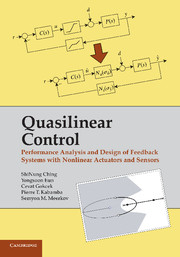 Quasilinear Control
Quasilinear Control Book contents
- Frontmatter
- Contents
- Preface
- 1 Introduction
- 2 Stochastic Linearization of LPNI Systems
- 3 Analysis of Reference Tracking in LPNI Systems
- 4 Analysis of Disturbance Rejection in LPNI Systems
- 5 Design of Reference Tracking Controllers for LPNI Systems
- 6 Design of Disturbance Rejection Controllers for LPNI Systems
- 7 Performance Recovery in LPNI Systems
- 8 Proofs
- Epilogue
- Abbreviations and Notations
- Index
Preface
Published online by Cambridge University Press: 01 June 2011
- Frontmatter
- Contents
- Preface
- 1 Introduction
- 2 Stochastic Linearization of LPNI Systems
- 3 Analysis of Reference Tracking in LPNI Systems
- 4 Analysis of Disturbance Rejection in LPNI Systems
- 5 Design of Reference Tracking Controllers for LPNI Systems
- 6 Design of Disturbance Rejection Controllers for LPNI Systems
- 7 Performance Recovery in LPNI Systems
- 8 Proofs
- Epilogue
- Abbreviations and Notations
- Index
Summary
Purpose: This volume is devoted to the study of feedback control of so-called linear plant/nonlinear instrumentation (LPNI) systems. Such systems appear naturally in situations where the plant can be viewed as linear but the instrumentation, that is, actuators and sensors, can not. For instance, when a feedback system operates effectively and maintains the plant close to a desired operating point, the plant may be linearized, but the instrumentation may not, because to counteract large perturbations or to track large reference signals, the actuator may saturate and the nonlinearities in sensors, for example, quantization and dead zones, may be activated.
The problems of stability and oscillations in LPNI systems have been studied for a long time. Indeed, the theory of absolute stability and the harmonic balance method are among the best known topics of control theory. More recent literature has also addressed LPNI scenarios, largely from the point of view of stability and antiwindup. However, the problems of performance analysis and design, for example, reference tracking and disturbance rejection, have not been investigated in sufficient detail. This volume is intended to contribute to this end by providing methods for designing linear controllers that ensure the desired performance of closed loop LPNI systems.
The methods developed in this work are similar to the usual linear system techniques, for example, root locus, LQR, and LQG, modified appropriately to account for instrumentation nonlinearities. Therefore, we refer to these methods as quasilinear and to the resulting area of control as quasilinear control.
- Type
- Chapter
- Information
- Quasilinear ControlPerformance Analysis and Design of Feedback Systems with Nonlinear Sensors and Actuators, pp. xiii - xviiiPublisher: Cambridge University PressPrint publication year: 2010
